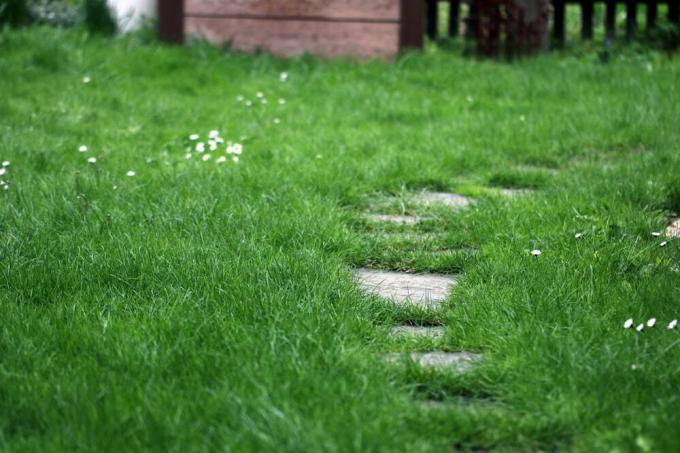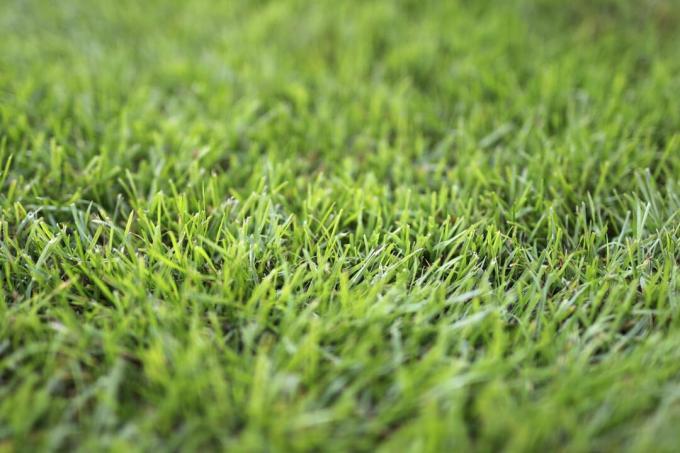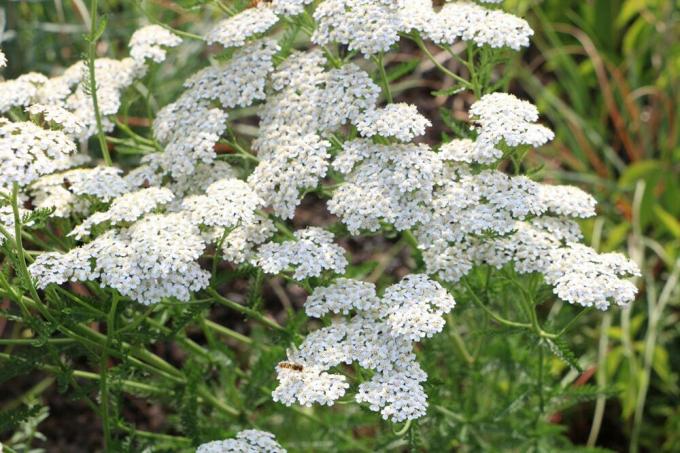

Table of contents
- Influencing Factors
- Lawn types and grass species
- germination time
- environmental factors
- accelerate growth
A beautiful lawn with a closed cover and a lush green color is the wish of many garden owners. Care plays a crucial role in this. The question of the speed of growth is justified, because the growth of the lawn determines the mowing cycle. However, how fast a lawn grows depends on various factors. The growth can be favored by special measures.
Influencing Factors
Every lawn takes a different amount of time to grow. It can take between seven and 20 days for the first stalks to sprout. The path from the seed to the blade of grass is a complex affair, the duration of which depends on various factors:
- grass type: fescue, meadow grass, ryegrass, bent grass
- Lawn type: Decorative lawn, sports lawn, shaded lawn
- environmental factors: temperature, light, precipitation
Lawn types and grass species
Ornamental lawns consist of fine-leaved species that show slow growth. Their maintenance effort is therefore comparatively low, because the leaf mass does not increase as quickly and the lawn does not have to be mowed as often. Sports and play turf are characterized by a high level of durability. They consist of particularly fast-growing and robust types of grass, which also close up bare spots again in a short time. Due to the faster development, this lawn needs to be mowed more frequently. Shade lawns contain different types of grass that can cope with low light. Development is a little slower in shady conditions, so this type of lawn requires less attention. Many of the grass species are also included in other mixes. Shady lawn contains high proportions of grove rep grass or meadowgrass.
- ornamental lawn: bent grasses, fescue
- sports turf: Ryegrass, meadow meadow grass
- shadow lawn: fescue, ryegrass, meadow grass
germination time
Different types of grass take different amounts of time to germinate. The germination time must therefore be taken into account for freshly laid lawns in order to obtain information about the growth rate. Like the growth of the grass, it depends on the environmental conditions. On average, these grasses have the following germination times:
- ryegrass: about seven to 15 days
- fescue: between ten and 20 days
- bent grasses: twelve to 20 days
- meadow grasses: approx. 14 to 24 days
A notice:
Even if the first tips of grass appear after a week, you should allow some time before the first mowing. When all the grass has reached a height of about eight centimetres, you can mow for the first time.
environmental factors

Growth is animated by a certain temperature. The soil temperature at a depth of about five centimeters is decisive. For healthy root and shoot growth, the temperature should be between 15 and 18 degrees Celsius. Once the seeds have developed cotyledons, sunlight plays an important role in subsequent development. Grasses use the sun's energy to produce nutrients. Sun-drenched lawns therefore grow faster than grasses in the shade. However, this only works if the water balance is right. Excessive solar radiation causes the grasses to lose a lot of water through evaporation. In the summer months, the water requirement per square meter is around five liters. When the sky is overcast, the need for liquid decreases.
A notice:
In autumn, the growth rate decreases steadily due to falling temperatures and reduced incidence of light. The culms stop growing at around five degrees Celsius air temperature, while root growth stops at -0.5 degrees Celsius.
accelerate growth
Loosen the soil thoroughly before sowing. As a result, the seeds fall into protective crevices in the ground, where even conditions prevail. Only cover the seeds thinly with substrate so that the sprouts can grow faster from the soil surface. Unwanted species should be removed quickly. Although most grass species are rather competitive and can hold their own against other plants, so-called weeds rob the grass of nutrients. Feed the seeds with a starter fertilizer. They provide the young grasses with important nutrients for rapid and healthy growth, with phosphorus making up a large proportion of the starter fertilizer.
- Nitrogen: growth of the leaves
- Potassium: increases resilience
- Phosphorus: rooting
Tip:
The young grasses must be able to utilize the nutrients as quickly as possible. Therefore, apply starter fertilizer one to two weeks before sowing.
 Home editorial office
Home editorial office
Learn more about lawn care

Sanding the lawn: how much sand per m²?
The lawn is the focal point of the garden. Sanding the lawn can effectively influence its appearance. However, there are a few things to consider, because too much of it can also damage the green. Read here how much sand you should apply per m² when sanding the lawn.

Overseed the lawn without scarifying?
Which hobby gardener doesn't dream of a dense, lush green lawn? Bald spots not only look unsightly, they also encourage weed growth. But can you overseed a lawn without scarifying it first?

Recognize and fight couch grass successfully | 10 tips
Couch grass is one of the most stubborn weeds. However, there are also differences here, because not every species becomes a problem in the garden. However, if the creeping or common couch grass is up to mischief, you can take action against it with perseverance and the right techniques.

Iron fertilizer: the right use in the lawn
Iron fertilizer supplies the lawn and works against moss. However, it has to be used correctly. Therefore, observe the following tips to achieve optimal results for the grass plants and to avoid damage to the meadow.

Does coffee grounds help against clover in the lawn?
Clover in the lawn is a nuisance that many garden owners struggle with. Lawns, which in some cases are interspersed with numerous nests, are often affected. As an alternative to chemical agents, many wonder whether coffee grounds are effective against weeds.

Yarrow in the lawn | How do I get rid of yarrow?
There is no question that yarrow is one of the best-known medicinal herbs. It helps against colds and is used for skin diseases and gynecological problems. On the manicured lawn, she is seen as a troublemaker. How do you get rid of them? Are there effective alternatives to the chemical club?

